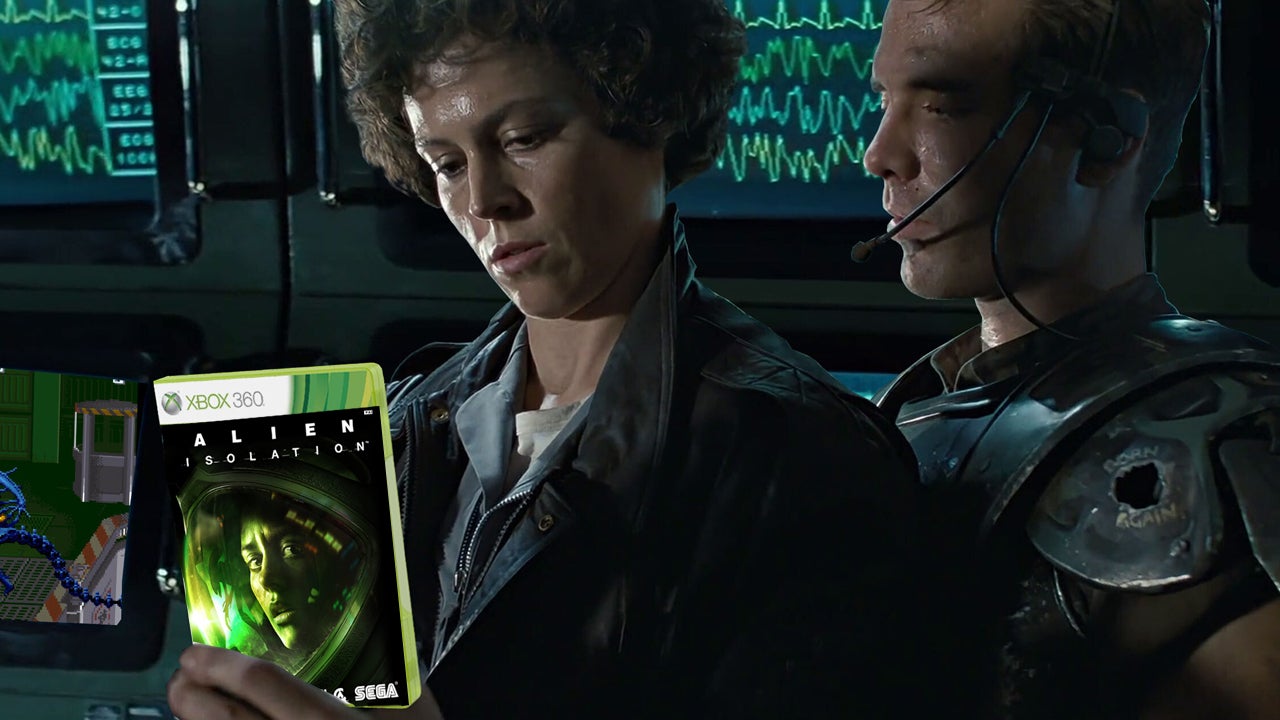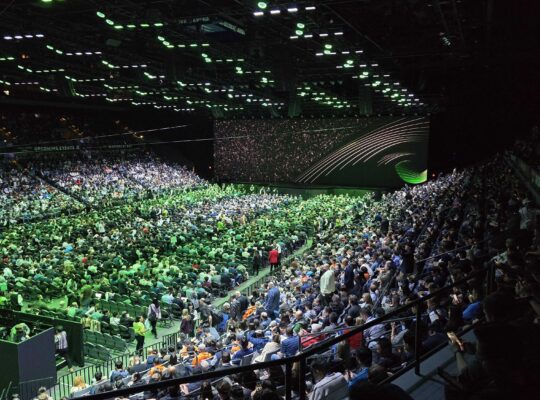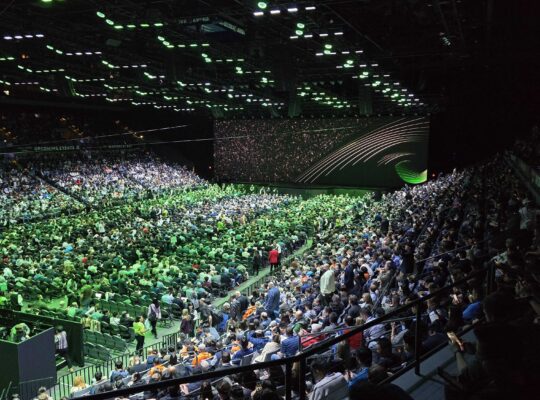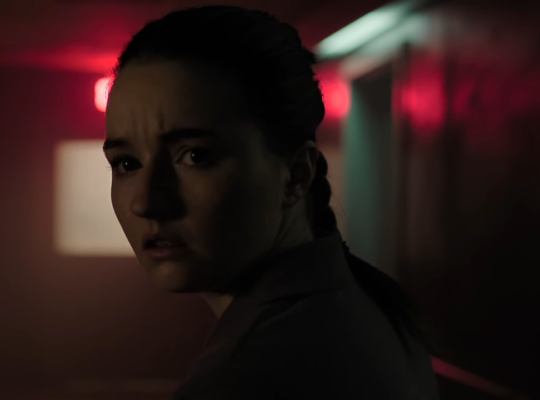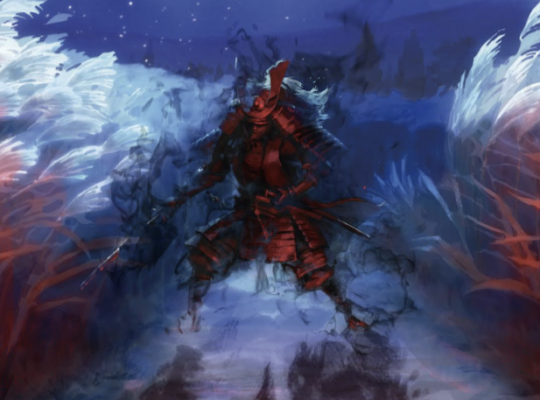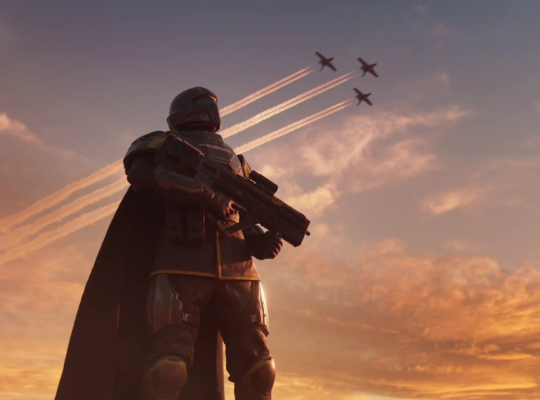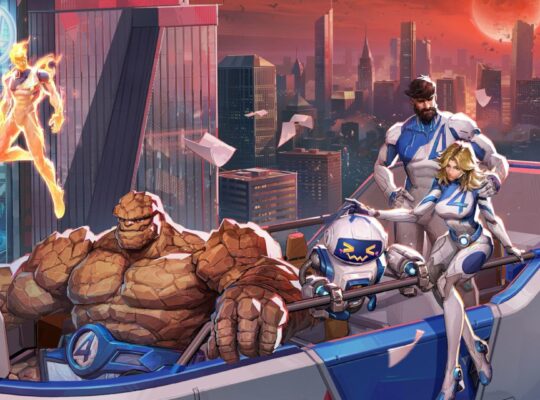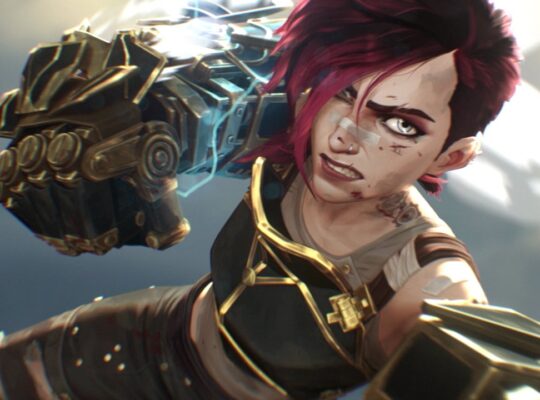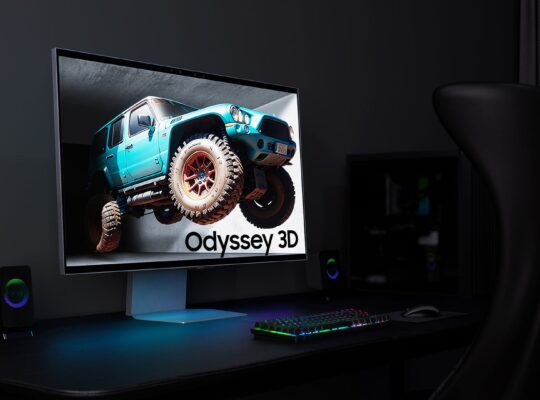1979’s Alien, written by Dan O’Bannon and directed by Sir Ridley Scott, is a sci-fi masterpiece which should need little introduction. A part sci-fi, part slasher smash hit of absolutely soaring standards, Alien is broadly regarded as one of the most important and influential science fiction and horror movies ever made – and deservedly so. It’s also a member of an elite list of fabulous film series that really should’ve stopped at just the one sequel. You know, like The Terminator. Or RoboCop. Or The Godfather. Or Home Alone. Or… Shrek.
Mate, we’ve only just started. At any rate, there’s not a lot that hasn’t been said about 1979’s Alien. What you may not know, however, is that Alien was already an established multimedia franchise well before its first theatrical sequel arrived in 1986.
The history of Alien video games stretches back over 40 years, beginning with Alien for the Atari 2600 in November 1982.
Alien (Atari 2600. 1982)
1982’s Alien was one of the earliest ever video games based on an official movie licence, an honour it was only marginally beaten to by Raiders of the Lost Ark (which also came out in November 1982 and holds the Guinness World Record as the first).
1982’s Alien was one of the earliest ever video games based on an official movie licence
Unfortunately, Alien wasn’t exactly a complex or ambitious tie-in. The technical limitations of the Atari 2600 notwithstanding, it wasn’t a unique one, either. In fact, it was just a Pac-Man clone. Ghosts became aliens, Pac-Dots became alien eggs, and Power Pellets became… pulsars. It’s pretty brazen. There is one key difference: it arms players with a limited flamethrower.
Well, yes, but in this case… it’s not a drastically effective tool to rely on.
1982’s Alien was programmed by Doug Neubauer, who had previously made the well-regarded space combat sim Star Raiders. Neubauer later explained his keenness to work with Fox Video Games stemmed from his assumption he’d have a chance to work on all its movie licenses at the time – including Star Wars, which was previously distributed by Fox, before Disney bought Lucasfilm, and then… bought Fox. Unfortunately for Neubauer, Fox didn’t have the video game rights for Star Wars.
While Neubauer traded his Star Wars aspirations for the Korean War and made a M*A*S*H game instead, Alien scuttled off to a new studio for a second game based on the original movie.
Alien (Commodore 64, ZX Spectrum. 1984)
1984’s Alien, from short-lived development studio Concept Software, was made for the Commodore 64 and ZX Spectrum (and Amstrad the following year). It admittedly isn’t much to look at but is a much more faithful interactive interpretation of the events of the movie. That is, this was no Pac-Man inspired maze game; rather, it’s a menu-driven strategy game that requires players to command the crew of the Nostromo as they attempt to either eject the Alien into space, or trigger the Nostromo’s self-destruct sequence and escape in the shuttle. Like the film, one of your team is secretly an android working to betray the rest of the crew.
With the original Alien movie licence under its belt and a big-screen sequel just around the corner, Concept Software moved on to… a video game adaptation of Paul McCartney’s Give My Regards to Broad Street, a film the late Roger Ebert described as a “non-movie”. Alien moved elsewhere, again.
Aliens: The Computer Game (Commodore 64, ZX Spectrum. 1986)
James Cameron’s action-packed and pleasingly pluralised Aliens had a pair of video game adaptations released the same year as the film: Aliens: The Computer Game, and… Aliens: The Computer Game. Yes, two different games; same name. You see, Activision had the rights to an Aliens game, and developed and published one itself for the North American market. However, Activision’s own UK subsidiary, Electric Dreams, had also developed its own, bespoke game at the same time – which was published in European territories. They were two entirely different games. Why they both shared an identical title is anyone’s guess.
Activision’s US version – first released on Commodore 64, and on Apple II the following year – was a collection of six different minigames designed to bring certain parts of the movie alive, from steering the drop ship down from the Sulaco to fending off the Alien queen in the power loader. The scattergun approach didn’t please everybody but the game enjoyed a decent reception based on the standards of the time for movie tie-ins.
It’s Electric Dreams’ UK version, however, that has the stronger legacy – and that’s thanks to several important innovations. Rather than a series of conventional minigames, the UK version of Aliens opted for a more consistent approach. The result was a first-person experience that placed us in the base down on LV-426, doing its darndest to simulate turning left and right in a 3D environment on ancient 8-bit hardware by wrapping scrolling 2D backdrops around the characters.
Aliens was also one of the first team-based combat games, with players in charge of the fate of six characters from the film – each of whom need to be moved, managed, and protected in order to make it through alive. Perhaps more than anything, though, at a time where even the most challenging games tended to top out at “stressful”, Aliens was outright scary.
Accompanied by the chilling beeping of motion trackers, picking your way through the labyrinthine base – which was so complex it was impossible to tackle without the game’s paper map – was frightening. Sure, it looks hopelessly primitive through a modern lens, but here was something that was doing justice to its bloodcurdling, big-screen brother. At the time of its release, the UK version garnered a heavy helping of praise as one of the best video game movie tie-ins of the ’80s.
Accompanied by the chilling beeping of motion trackers, picking your way through the labyrinthine base – which was so complex it was impossible to tackle without the game’s paper map – was frightening.
To add to the confusing state of affairs, Electric Dreams released Activision’s US version of Aliens: The Computer Game on Commodore 64 and Spectrum in Europe anyway, which it called Aliens: The Computer Game – US Version.
But hey, it’s still a better name than the next game in this list, which is 1987’s Aliens: Alien 2. Assuming gamers were too stupid to realise Aliens was the sequel to Alien was certainly an interesting approach.
Aliens: Alien 2 (MSX. 1987)
Aliens: Alien 2 was ultimately only released on MSX in Japan, and to be honest, if we’re going to talk about a side-scrolling Aliens game out of Japan, it ain’t going to be this one from Square.
It’s going to be 1990’s arcade-only smash hit: Aliens, from Konami.
Aliens (Arcade. 1990)
Aliens is a grand and gory side-scrolling shooter from the golden age of arcades, and was reportedly Konami’s second best-selling arcade game for 1990, right after the all-conquering Teenage Mutant Ninja Turtles. It’s one that likely holds a special place in the hearts of kids who grew up cruising aisles of colourful cabinets clutching a fistful of coins – even if Konami unfortunately forgot what colour Sigourney Weaver’s hair was.
A fast and loose riff on the final act of James Cameron’s film, Aliens sees players mowing down wave upon wave of Xenomorphs as Ripley strides through the infested base. A second player can even tag along as Hicks. Konami saw fit to invent a number of new Alien types for the game, too, which kept things varied up until Ripley’s inevitable final showdown with the queen.
Of course, getting there was no cakewalk, as Aliens was tough. Not as hard to crack as Contra, perhaps, but certainly unafraid to overwhelm players long before the credits roll and their pockets are already empty.
Meanwhile, the Alien film series scurried back into cinemas in 1992 with Alien 3, the poster for which famously promised three times the suspense, three times the danger, and three times the terror. It also promised at least three times the salary for Sigourney Weaver, by all reports. Unfortunately, the end result was shonky enough for director David Fincher to completely disown the whole thing, and James Cameron later declared the decision to immediately kill off everyone but Ripley was a slap in the face to fans of the previous film, entirely undermining everything that happened in Aliens. Good thing Cameron learned never to make such an infuriating, franchise-derailing, mean-spirited mistake himse-
Anyway, regardless of whether or not the Alien series should’ve kept going, they did, and so did the games.
Alien 3 (SEGA Genesis, Super NES, NES. 1992)
Alien 3’s first movie tie-in, most versions of which were from Probe Software, came to essentially every platform available at the time, including Mega Drive (or Genesis, depending on where you grew up) all the way back to the Commodore 64 – which was a decade old at that time. Game Boy, Game Gear, NES and Super NES, you name it., Alien 3 was on it. While there were a range of differences across platforms, each basically boiled down to navigating Ripley through the prison colony that featured in the film, liberating inmates and liquidating Aliens. They also all shared punishing time limits on completing the levels.
Alien 3: The Gun (Arcade. 1993)
In addition to this home console, 2D platformer, Sega published an unrelated, Alien 3 arcade rail shooter in 1993 which, in the spirit of badly-named Alien games, was called Alien 3: The Gun. It’s an absolutely terrible name, but the game does totally ignore the plot of the movie, which is what I’ve also done since the ’90s, so I’ll salute it for that.
Alien 3: The Gun brushes aside almost every element of Alien 3 The Movie, opting instead for a threadbare story about two Colonial Marines responding to an SOS beacon from the Sulaco, crashing on the Fiorina 161 prison planet, and blasting wave after wave of Aliens to bits. We are, of course, talking about a light gun game designed to played in several minute bursts when the line for NBA Jam is too long, so it’s fair not to expect too much – but with two hefty M41A Pulse Rifles perched on the front, it was certainly the closest you could come to immersing yourself and a friend into the world of Alien and experiencing the frantic firefights firsthand.
Alien Vs Predator (Super NES. 1993)
1993 also saw the arrival of Alien vs. Predator on Super NES, developed by Japanese studio Jorudan, which stopped making video games some time ago and now operates a public transit planning website.
Well, actually, I think that’s exactly what it does, but yes, we should move on because this may take a little explaining.
Aliens vs. Predator is a series that began as a Dark Horse comic book short story in 1989, before expanding into its own limited series in 1990, and subsequently into a fully-fledged multimedia franchise of its own.
Technically speaking, Aliens vs. Predator is an entirely adjacent series to Alien, and while there’s been definite synergy between AVP and the Predator series – and it’s been established these particular xenomorphs do exist within the Predator universe – AVP has never been acknowledged in Alien. In fact, the most recent Alien movies have been fiercely contradictory to AVP lore. As such, we should probably ignore the AVP series in this History of Alien games.
Okay, fair enough. Well, Jorudan’s Super NES Alien vs. Predator beat ’em up wasn’t a particularly great game, nor was the charmless Alien vs Predator: The Last of His Clan for Game Boy, released the same year. The lukewarm reception of the former meant its planned Sega and PC ports were abandoned, and a direct Atari Jaguar port was also binned after Atari brought on UK developer Rebellion, otherwise best known now for its Sniper Elite series, to create a bespoke Alien vs Predator first-person shooter instead.
Alien Vs Predator (Atari Jaguar. 1994)
1994’s Alien vs Predator for the Jaguar, which took a heavy dose of inspiration from Wolfenstein 3D and Doom, is generally regarded as one of the greatest games ever released on Atari’s ill-fated final console, although that admittedly is a sadly small list. Alien vs Predator on Jaguar allows players to battle as an Alien, a Predator, or a human Colonial Marine, each of whom have different abilities. Aliens, for instance, can use air ducts to move around the levels and, while they can’t heal, they can respawn and continue from cocooned people they, er, impregnate along their path.
Aliens, for instance, can use air ducts to move around the levels and, while they can’t heal, they can respawn and continue from cocooned people they, er, impregnate along their path.
Alien Vs Predator (Arcade. 1994)
In the meantime, in 1994 Capcom also released its own Alien vs. Predator game, an arcade-only beat ’em up completely unrelated to Jorudan’s Super NES version from 1993. It’s one of the best-looking 16-bit beat ’em ups ever made, and one of the most-esteemed of its era.
Okay, so do we go through the rest of the AVP games now or later?
Aliens Versus Predator (PC. 1999)
Fine, well, Rebellion had another crack at the series with 1999’s Aliens Versus Predator for PC, which rescued the spirit of the original from being forever marooned on a defunct console. 1999’s Aliens Versus Predator again featured three campaigns and, while its multiplayer copped some criticism for balance issues, its superb single-player component saw it snag a reputation as one the strongest sci-fi shooters of its era.
Aliens Versus Predator 2 (PC. 2001)
The series continued in 2001 with Aliens Versus Predator 2, again on PC, but this time with No One Lives Forever and F.E.A.R. studio Monolith Productions at the helm. Here the campaigns for both of the titular creatures and the Colonial Marines actually crossed over. It garnered strong praise, although its 2002 expansion Aliens Versus Predator 2: Primal Hunt was less warmly received.
Aliens Versus Predator: Extinction (PS2, Xbox. 2003)
After the underwhelming 2003 Xbox and PS2 RTS Aliens Versus Predator: Extinction, plus a string of forgotten mobile and web games, Rebellion returned to its lead role behind this series – first with 2007’s Aliens Versus Predator: Requiem on PSP, a dud third-person action game where you only play as Predator, and later with 2010’s Aliens vs. Predator reboot for Xbox 360, PS3, and PC. The Aliens vs. Predator reboot followed the same template that had served the series well in the past – with a campaign for each of the three featured species – but while it nailed the atmosphere and dialled up the gore, it was disappointing elsewhere.
But while that’s a wrap for the AVP games to date, we’ll need to do an about face to return to the Alien series.
Well, we have to, because we’ve skipped over a whole bunch of them.
Aliens: A Comic Book Adventure (PC. 1995)
1995 saw the release of Aliens: A Comic Book Adventure, a below-par point-and-click game from Mindscape, starring a spaceship commander who we’re supposed to believe doesn’t have an elevator keycard for his own vessel. Mindscape’s gambit to licence the property directly from Dark Horse comics rather than Fox didn’t work, as it turns out that in space, everyone can still hear you scheme. Fox cracked down immediately and sank any further production.
Alien Trilogy (PlayStation, Saturn, PC. 1995)
Around the same time, Fox partnered with Probe for the first-person shooter Alien Trilogy, which came to PlayStation, Saturn, and PC in early 1996. Acclaim picked up publishing after acquiring Probe in late 1995. An extremely loose riff on the films – of which there were only three at the time – Alien Trilogy arrived right in the heart of the era where first-person shooters were still far more commonly referred to as Doom clones. The moniker wasn’t always applied as a pejorative, though, and on PlayStation in particular, Alien Trilogy became a strong seller that received praise for its atmospheric take on the Alien universe – which was bolstered with sound effects lifted straight from the films.
Alien Trilogy was actually one of two Fox film adaptations from Probe in 1996 alone; a separate Probe team was simultaneously building Die Hard Trilogy, published under a pre-existing deal with EA later the very same year.
Aliens Online (PC. 1998)
1998 saw the arrival of MMO FPS Aliens Online, a completely extinct, multiplayer shooter from the dial up days. Aliens Online was available for just two years on the short lived GameStorm online gaming service, before EA pulled the plug in mid-2000 after it acquired the platform.
Alien Resurrection (PlayStation. 2000)
That’s corpos for you, Hudson. In 2000, the long-gestating PlayStation 1-exclusive Alien Resurrection finally arrived, albeit shortly after the debut of the PlayStation 2. Alien Resurrection had been intended to ship alongside the 1997 movie, but multiple iterations of the game had floundered in development hell at Argonaut Games for several years. Following the release of Argonaut’s Alien Odyssey – which, for clarity, was an alien game, but wasn’t an Alien game – work on Alien Resurrection began in 1996. Initially conceived as a top-down shooter, Argonaut restarted development in late 1996, opting for a more cutting-edge approach inspired by the likes of Tomb Raider, but then pivoted again to a first-person shooter in late 1998 after it had become evident the third-person view simply wasn’t working.
Unfortunately, while Argonaut had eventually found the right formula after four years of development – and the game was surprisingly more decent than the movie it shared a name with – Alien Resurrection failed to find a large audience. Its punishing difficulty could’ve certainly played a part, but the simpler explanation is probably the fact that there wasn’t much appetite for a game based on the least successful Alien move to date, three years after it hit cinemas.
In an odd twist, upon its release Alien Resurrection copped significant critical flak for its default, dual-analogue control system, where the left stick controls your movement and the right stick handles turning, and looking up and down.
You might recognise this control solution from… every first-person shooter made this century, but back in 2000 Alien Resurrection was hugely ahead of its time, and certainly part of an elite squad of shooters that pioneered modern console FPS controls before Halo swept in and took all the credit. It wasn’t quite the first, though, despite what you may have heard – 1999’s Medal of Honor features modern, dual-analogue controls as one of its preset configurations, and GoldenEye on N64 features them too, if you choose the mode that uses a separate controller in each hand (although you do need to swap right for left after the fact).
Yeah, it is like Switch joycons this way. Good point.
Aliens: Thanatos Encounter (Game Boy Colour. 2001)
Speaking of Nintendo, 2001 saw the release of Aliens: Thanatos Encounter from Wicked Witch Software, a top-down shooter that was exclusive to Game Boy Color, so it’s invariably a lot more primitive than its PC and console peers of the time, although positively bleeding edge compared with 2003’s Aliens: Unleashed for mobile.
Aliens: Extermination (Arcade. 2006)
In 2006, the series returned to arcades with the light gun shooter Aliens: Extermination from Big Buck Hunter developer Play Mechanix, before sneaking back onto a Nintendo handheld again in 2011, with Aliens: Infestation for DS, from WayForward Technologies.
Aliens: Infestation (DS. 2011)
Primarily inspired by James Cameron’s Aliens, Aliens: Infestation was a well-received, Metroidvania spin on Aliens, and with its beautiful, hand-drawn 2D art – and a set of levels that took players back to the Sulaco and LV-426 – it was an authentically old-school Alien game. Its interesting hook was permadeath for its cast of characters, and specific dialogue for each. Just like the movies, the idea was for players to become attached to certain characters within their party before they were killed in your particular playthrough.
Just like the movies, the idea was for players to become attached to certain characters within their party before they were killed in your particular playthrough.
Aliens: Infestation was developed in tandem with Gearbox and Sega’s Aliens: Colonial Marines, although the latter didn’t emerge from its cocoon until 2013.
Aliens: Colonial Marines (PS3, Xbox 360, PC. 2013)
With performances from Aliens stars Lance Henriksen and Michael Biehn – whose death in Alien 3 was retconned from the timeline – Aliens: Colonial Marines was pitched as a new, direct sequel story to Aliens. Influential sci-fi concept artist Syd Mead – famous for his work on Blade Runner, Tron, and Aliens itself – was even brought on to ensure the world of Aliens: Colonial Marines perfectly matched the film upon which it picks up from. Unfortunately, after a lengthy and clearly rocky gestation of around six years, matching the Alien aesthetic is about all it managed.
Yeah, you’re telling us. Bafflingly unrefined considering its development period, Aliens: Colonial Marines also misses the entire point of Aliens by turning what are supposed to be the most lethal lifeforms in the galaxy into pulse rifle fodder for a routine, run ‘n’ gun shooter. The only scary thing in its six-hour campaign was its startlingly spotty understanding of the facts of Aliens. That is, why does it take the crew of Aliens: Colonial Marines 17 weeks to reach LV-426 after receiving Hicks’ distress call, after Hicks clearly explained during Aliens that they could expect a rescue team to arrive after 17 days, even without them sending a distress call? 17 doesn’t feel like a coincidence; that feels like a mistake. Of course, that’s nothing compared to the fact Hadley’s Hope itself is still standing in the first place after the explosion of the Atmosphere Processing Plant that vapourised everything within a 30 kilometre radius.
Sega would earn some redemption the following year – not with 2014’s Aliens: Armageddon, which was an arcade-only follow-up to Aliens: Extermination, again developed by Play Mechanix – but rather with the sneaky and survival horror-themed Alien: Isolation.
Alien: Isolation casts players as Ripley’s daughter Amanda, whose quest for closure concerning her mother’s disappearance drags her into her very own close encounter of the worst kind.
Alien: Isolation (PS3, Xbox 360, PC. 2014)
Set 15 years after the events of the original Alien, Alien: Isolation casts players as Ripley’s daughter Amanda, whose quest for closure concerning her mother’s disappearance drags her into her very own close encounter of the worst kind. Inspired primarily by the original rather than its action-heavy sequel, Isolation is built around stealth rather than slaughter. Evading the bloodthirsty Alien randomly stalking the space station Sevastopol is your only option, and the anxiety that Isolation elicits is proof developer Creative Assembly – a studio otherwise largely famous for its Total War strategy series – genuinely understood the terrifying spirit of the film world it was allowed to recreate. Alien: Isolation’s trial-and-error terror may get a little exhausting at times, but it really is a licensed movie game of uncommon quality.
Hell, the original cast of the 1979 film even returned to reprise their roles in pre-order DLC for Isolation, including Tom Skerritt, Veronica Cartwright, Harry Dean Stanton, Yaphet Kotto, and yes, Sigourney Weaver herself.
Following Alien: Isolation, there are only a few more games to note. In 2016, an Alien appeared as a guest character in Mortal Kombat X. Alien: Blackout was a mobile-only Five Nights at Freddy’s clone released in 2019 – also starring Amanda Ripley – but it was delisted in 2023.
In 2021, an Alien and Ripley appeared as another pair of absurdly expensive character skins in Fortnite, the game that normalised DLC being so overpriced you can buy an entire video game for the price of one or two character models.
Aliens: Fireteam Elite (PS4 / 5, Xbox One / Series S / X, PC. 2021)
Tell me about it. Anyway, Aliens: Fireteam Elite also came out in 2021, which is a three-player co-op third-person shooter from Cold Iron Studios, set a couple of decades after the end of Alien 3.
In stark contrast to Alien: Isolation, Fireteam Elite is a return to gunslinging and painting the walls with alien goo – but for a game with modest aspirations it certainly had a more convincing crack at it than Colonial Marines.
Fireteam Elite is a return to gunslinging and painting the walls with alien goo.
Aliens: Dark Descent (PC. 2023)
2023’s Aliens: Dark Descent, from Tindalos Interactive, is a curious mash-up of isometric, squad-based, RTS action, with genuine survival horror elements – but it’s a combo that works surprisingly well, and an admirably unique concept amongst a series of games that date back 40 years.
In late 2023, an Alien and a distinctly off-brand Ripley also debuted as licensed guest characters in the asymmetric multiplayer horror game Dead by Daylight, joining a swarm of slasher movie superstars from Scream, Halloween, A Nightmare on Elm Street, and many more.
But other than Alien: Rogue Incursion, a single-player action-horror VR game with an otherwise unspecified 2024 release date, that about covers it.
In the meantime, if you haven’t already, check out IGN’s review for Fede Alvarez’s Alien: Romulus, but if that’s too scary for you, perhaps you can check out our history of Teenage Mutant Ninja Turtles games instead.
Luke is a Senior Editor on the IGN reviews team. You can chat to him on Twitter @MrLukeReilly.


